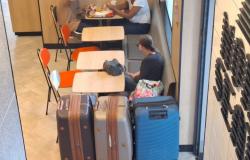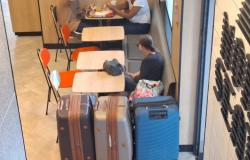
The Ministry of Indigenous Peoples (MPI) estimates that around seven thousand illegal miners continue to be active in Yanomami Land. The calculation was reported this Tuesday (26) by the National Secretary of Indigenous Territorial Rights of the MPI, Marcos Vesolosquzki Kaingang, in a press conference on Operation Catrimani, coordinated by the Army.
O number of attackers decreased by 65% in one yearcompared to the beginning of federal government operations, when there were 20,000 invaders in the territory.
Now, the federal government is preparing a new phase for the withdrawal of miners with the establishment of the Government House in Roraima, where most of the Yanomami Land is located and the focus of the humanitarian crisis.
“Today we have an estimate of 6 to 7 thousand miners or less than that, but they are miners who continue doing the miners’ work, which is putting the lives of the Yanomami at risk. […] This is one of the first steps in territorial protection, the presence of the Brazilian state is crucial and in this there will be an operation that the [Nilson] Tubino [diretor da Casa de Governo] It will coordinate very well”, he said.
At the press conference, representatives of the Armed Forces, the National Foundation of Indigenous Peoples (Funai) and the House of Government commented on the results of operation Catrimani, which began in January, when the health emergency completed one year, to act in an emergency manner in the territory.
Catrimani was created through ordinance No. 263 of the Ministry of Defense and allowed the delivery of 15 thousand basic food baskets in the territory. The Brazilian Navy, Brazilian Army and Brazilian Air Force (FAB) participated in the operation.
As a result, the Armed Forces presented the following numbers:
- 374 soldiers involved;
- 2,400 flight hours;
- 1,100,000 L of aircraft kerosene used;
- 330,000 kg baskets transported;
- 11,800 baskets thrown;
- 5 aeromedical evacuations;
- 3 support for the Federal and Civil Police.
Now, with the Government House functioning, the military must support the federal government’s permanent actions in the territory. In the new phase, the government must act on three fronts: disintrusion of mining, health and food, with the continued delivery of basic food baskets to indigenous people.
“This work will be continued with new logistics, another structure […] to free up the Armed Forces to contribute to other operations […] The Government House has the role of articulating these bodies towards a common objective”, explained Nilson Tubino, the head of the government house in Roraima.
Although it has the direct participation of the seven ministries, the federal government states that all federal bodies are involved in what is called “permanent actions”. The Government House will operate until December 31, 2026, under the coordination of the Civil House of the Presidency of the Republic.
Operation Catrimani took place jointly between the Armed Forces and the Ministry of Indigenous Peoples. With the mobilization of the military, 200 communities were served with basic food baskets. Deliveries were coordinated by Funai.
During logistical support, the Armed Forces covered 680,000 km, which according to the Chief of Staff of the Catrimani Joint Operational Command, Brigadier Eduardo Miguel equivalent to 17 revolutions around the earth.
Due to the size of the territory, considered the largest Indigenous Land in Brazil, the head of the Operational Command assessed that the biggest challenge was overcoming long distances by air, because it is the only way to access the communities.
“We don’t have a road, we don’t have a river, so we have to cover all this distance by air means. This brings an additional difficulty because these air means need to be supplied with fuel from the location we are going to get to.”
For this, a UH-15 helicopter from the Navy, an HM-1 from the Army and the Black Hawk from the FAB were used. In addition, the FAB’s C-105 aircraft was also used.
In Funai’s assessment, the operation had good results, as the number of delivery points within the territory increased from 90 to 177, according to the coordinator of Funai’s Yanomami Ethno-environmental Protection Front Elayne Rodrigues Maciel.
“I say with great certainty that we managed to serve the entire critical region of Auaris and Surucucu. We have no news of any community that has not received it,” he stated.
However, according to the coordinator, the indigenous people themselves do not intend to continue receiving the baskets. Support will only be necessary as long as it is not possible to remove food from the fields they have created. With the beginning of the deintrusion of mining, Funai has already identified several farm points throughout the territory.
Due to the increase in illegal mining in recent years, they were unable to plant food, because the activity devastates the territory and scares away hunting. Sick adults are unable to look for food for the family or cultivate crops.
“You need to have this patience and understand that these are cycles and that they will still need this food so as not to run the risk of having to take the food from a new field and again having a situation of food insecurity there, but what we have What I noticed is that it has worked very well”, said the coordinator.
Operation Catrimani publishes results
The Yanomami Land is considered the largest indigenous territory in Brazil. The region is facing an unprecedented crisis, with serious cases of indigenous people suffering from malaria and severe malnutrition. The crisis was worsened by the spread of illegal mining, especially in recent years.
In January 2023, the federal government began creating actions to face the crisis, sending health professionals, basic food baskets and materials to help the Yanomami. Furthermore, security forces were sent to the region to stop the activity of miners in the territory.
Even with the confrontation, a year after the government declared an emergency, illegal mining and the humanitarian crisis remain in the region.
Tags: thousand miners continue operate Yanomami Land Ministry Indigenous Peoples Roraima
--




